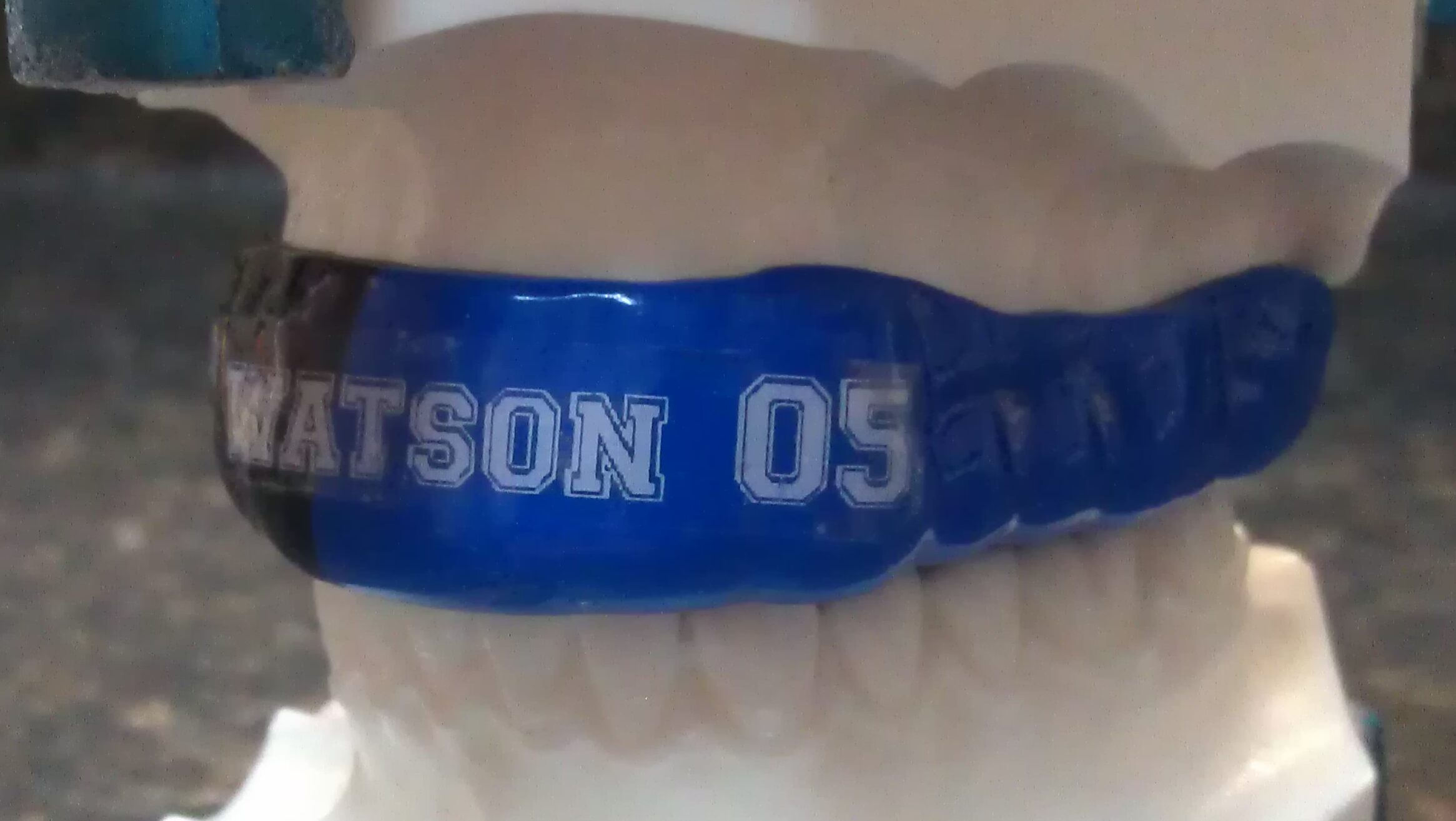Custom Laminated Sports Mouthguards: The Professional Standard for Athletic Dental Protection

Introduction
As dental professionals, we play a crucial role in protecting our patients’ oral health both on and off the field. While the importance of mouthguards in preventing dental trauma is well-established, the significant differences between custom laminated, single-layer custom, and over-the-counter options are often underappreciated. This article examines the evidence-based advantages of custom laminated mouthguards and provides practical guidance for recommending appropriate protection levels based on sport and competitive level.
The Science Behind Sports-Related Dental Trauma
Sports-related dental injuries account for up to 39% of all dental trauma cases, with an estimated 5 million teeth avulsed annually in the United States alone. The lifetime cost of treating a single avulsed tooth can range from $5,000 – $20,000, making prevention through proper mouthguard use both clinically and economically essential.
Common Sports-Related Dental Injuries:
- Crown and root fractures
- Tooth intrusion/extrusion
- Avulsion
- Soft tissue lacerations
- TMJ injuries
- Concussion (emerging evidence suggests properly fitted mouthguards may reduce concussion risk)
Mouthguard Categories: A Comparative Analysis
1. Over-the-Counter “Boil and Bite” Mouthguards
Construction: Thermoplastic material that softens in hot water
Fit: Self-adapted by patient
Thickness: 1.5-3mm (often inconsistent)
Retention: Poor to moderate
Protection Level: Minimal to moderate
Limitations:
- Inconsistent thickness after adaptation
- Poor retention requiring constant jaw clenching
- Limited coverage of posterior teeth
- Frequent replacement needed (3-6 months)
- Interference with breathing and speech
2. Single-Layer Custom Mouthguards
Construction: Single sheet of EVA material vacuum-formed over patient model
Fit: Precise adaptation to patient’s dentition
Thickness: 3-4mm (often inconsistent, thin at incisal edge)
Retention: Excellent
Protection Level: Moderate
Advantages over OTC:
- Superior fit and retention
- Better posterior coverage
- Improved comfort and compliance
- Longer lasting (12-24 months)
3. Custom Laminated (Multi-Layer) Mouthguards
Construction: Multiple layers of EVA & possibly hard layers of polypropylene, polyethylene or polycarbonate material pressure-laminated over patient model
Fit: Precise adaptation with customizable thickness zones
Thickness: 3-6mm (strategically varied)
Retention: Excellent
Protection Level: Superior
Unique Advantages:
- Strategic thickness distribution (thicker in high-impact zones)
- Enhanced shock absorption through multiple material interfaces
- Customizable hardness combinations (soft inner/hard outer layers)
- Superior durability (24-48 months typical lifespan)
- Optimal force distribution across dental arch
The Biomechanical Advantage of Lamination
Consistent thickness comparison

When working with a single layer mouthguard, there’s an unavoidable challenge tied to the “thermoforming effect”: no matter which material or machine you use, the mouthguard will always be thinner at the incisal edges when the material stretches from a flat disk to the 3 dimensional shape of the model. This thermoforming effect is at least 30% on a .5-.75 inch model & greater as the height of the model increases. Increasing the material thickness to 5 mm or more isn’t the answer: the mouthguard will still be too thin at the incisal edges and overly thick in the palate and gum (where extra bulk is unwanted).
So how do you solve this problem? There’s only one reliable method: custom laminated mouthguards. By layering materials, Because every layer after the first immediately bonds to the previous layer as its being formed, counteracting the thinning of the thermoforming effect. Custom lamination immediately boosts protection by up to 40%. In fact, it lets you build a mouthguard with 400%–500% more protection than what’s possible with a single sheet of material.
Force Dissipation Comparison
When impact force is applied:
- OTC Mouthguard: Force concentrated at point of impact, minimal distribution
- Single-Layer Custom: Improved distribution across occlusal surface
- Laminated Custom: Force dissipated through multiple layers, maximum distribution across entire arch


Shock Absorption Properties
Research demonstrates that laminated construction provides:
- 35% better shock absorption than single-layer custom
- 70% better shock absorption than boil-and-bite types
- Reduced transmitted force to teeth, periodontium, and TMJ
Patient Compliance Factors
Studies show 90% compliance with custom laminated mouthguards versus 40% with OTC options, attributed to:
- Superior comfort and fit
- Minimal interference with breathing
- Clear speech capability
- No need for constant jaw clenching
- Aesthetic color/design options
Cost-Benefit Analysis
While custom laminated mouthguards require higher initial investment:
- OTC: replaced 2-4x+/year
- Single-Layer Custom: 1-2 year replacement
- Laminated Custom: 2-4 year replacement
When factoring in superior protection and compliance, laminated custom mouthguards provide optimal value.
Choosing Weight & Thickness
We at Fox Valley Ortho Lab are here to help you determine the design & construction of the mouthguard based upon sport, competitive level and age of athlete. We will use a combination of
- EVA Mouthguard material: each layer ranges from 1-4mm
- EVA Powerbands: Increased protection in customizable zones
- Hard inner layers: Using inner hard shells of different thickness/hardness to distribute load

Sport-Specific Recommendations
Construction and Thickness Guidelines
| Sport Category | Risk Level | Recommended Type | Thickness | Construction Details |
|---|---|---|---|---|
| CONTACT SPORTS | ||||
| Football | Very High | Heavy Laminated | 5-6mm | 3-4 layers, w/optional hard or powerband inner layer |
| Ice Hockey | Very High | Heavy Laminated | 5-6mm | 3-4 layers, hard inner layer |
| Boxing/MMA | Extreme | Heavy Laminated Pro | 6mm | 3-4 layers, hard inner layer |
| Rugby | Very High | Heavy Laminated | 5-6mm | 3-4 layers, w/optional hard or powerband inner layer |
| LIMITED CONTACT | ||||
| Basketball | High | Medium Laminated | 4-5mm | 2-3 layers |
| Soccer | High | Medium Laminated | 4-5mm | 2-3 layers |
| Field Hockey | High | Medium Laminated | 4-5mm | 2-3 layers |
| Lacrosse | High | Medium Laminated | 4-5mm | 2-3 layers |
| NON-CONTACT | ||||
| Baseball/Softball | Moderate | Light Laminated | 3-4mm | 2 layers |
| Skateboarding | Moderate | Light Laminated | 3-4mm | 2 layers |
| Mountain Biking | Moderate | Light Laminated | 3-4mm | 2 layers |
| Gymnastics | Low-Moderate | Single Layer Custom | 3mm | 1 layer |
Age and Competition Level Modifiers
| Competition Level | Thickness Modifier | Special Considerations |
|---|---|---|
| Youth (Under 12) | Standard | Frequent replacement due to growth |
| Middle School | Standard | Mixed dentition considerations |
| High School | Standard to +1mm | Increasing impact forces |
| College/Elite | +1-2mm | Maximum protection priority |
| Professional | +2mm | Custom specifications per sport |
Special Clinical Situations
| Clinical Condition | Modification Required |
|---|---|
| Orthodontic Appliances | Extra space, frequent adjustment |
| Class II/III Malocclusion | Modified extension/thickness |
| TMJ Disorders | Reduced vertical dimension |
| Previous Dental Trauma | Reinforced affected area |
| Dental Implants | Additional thickness over implant sites |
Clinical Considerations for Custom Laminated Mouthguards
Choosing your mouthguard sounds complex but with Fox Valley ortho lab as your partner it can be as simple as providing patient information & selecting a color.
- Patient Age
- Competitive level
- Sport(s) played
- Special considerations (Dental appliances/restorations, TMJ etc.)
Impression Technique
- Full-arch alginate or digital scan required
- Capture 2-3mm beyond gingival margins
- Include palatal rugae for retention
- Opposing arch recommended for occlusal adjustment
Design Specifications
- Labial Coverage: 2-3mm above gingival margin
- Palatal Extension: 10-12mm from gingival margin
- Posterior Coverage: Full occlusal surface to distal of first molars (minimum)
- Occlusion: Balanced contacts in centric relation
Conclusion
Custom laminated mouthguards represent the gold standard in sports dental protection, offering superior shock absorption, force distribution, and patient compliance compared to single-layer and OTC alternatives. As dental professionals, recommending appropriate protection based on sport-specific risk levels and individual patient factors is essential for preventing costly and traumatic dental injuries.
The initial investment in custom laminated protection is minimal compared to the potential cost of treating sports-related dental trauma. By educating our patients and their parents about these critical differences, we can significantly reduce the incidence of preventable sports-related dental injuries while promoting lifelong oral health.
For more information on incorporating custom laminated mouthguards into your practice, contact Fox Valley Orthodontic Laboratory for material options and fabrication specifications.
Stay safe 🙂
